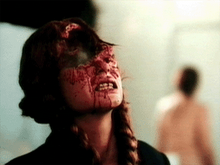There must have been something in the water in late-'80s Hollywood that caused so many filmmakers to make movies about something in the water. The 1989 release schedule was crammed up the wazoo with movies about deep ocean crews encountering something unusual under the sea. (Speaking of under the sea, The Little Mermaid was also released in 1989.) On the big-budget side, James Cameron followed up his mega-hit Aliens with The Abyss, a story about a SEAL team encountering aliens in the depths of the Cayman Trough, released in August of '89. In April, ultra-low-budget king Roger Corman retooled an unfilmed 1982 screenplay to cash in on the fad with Lords of the Deep, about aliens attacking an underwater colony of humans. (Hilarious fact about that movie: future award-winning cinematographer Janusz Kaminski was on the second unit crew and was fired because his footage looked too good, making the rest of the film look even worse by comparison, though they did eventually use portions of it.) In March, Rambo: First Blood Part II and Tombstone director George P. Cosmatos got in on the undersea action with his mid-budget Leviathan, the story of a deep-sea mining crew battling a giant monster in the Adriatic Sea.
Friday the 13th director Sean S. Cunningham shrewdly (some may say cynically) realized how many of these movies were on the '89 release schedule and hatched a plan to deliver a low-budget (in Hollywood terms) but professional sea monster movie as quickly as possible to beat them all into theaters. He succeeded, and DeepStar Six premiered on January 13, 1989, to mostly negative reviews and mediocre box office. (To continue this deep-sea circle jerk, DeepStar Six screenwriter Lewis Abernathy would later snag an acting role in Abyss director Cameron's Titanic.) It's far from an original piece of work and hits a lot of the familiar beats and grooves of the crew-on-a-mission movies, but seen through a 2025 lens, DeepStar Six is a solid and entertaining action/sci-fi/horror movie of modest budget like they used to make 'em before everything had to be green-screen world-building Best Buy-lighting-looking eleventy billion dollar horseshit. Is mainstream Hollywood filmmaking so washed up that mediocre films from the '80s now look like shining gems? Possibly. (Just so you don't think I'm an old man yelling at a cloud, I do think dozens of great movies are still being made every year, but very few of them within the Hollywood system or the major independents.)
DeepStar Six takes place on an experimental undersea facility run by the U.S. navy with a crew made up of navy personnel and civilian contractors. The facility serves two purposes for the navy: a place to test underwater colonization and a location to construct a storage area for nuclear missiles. The current crew is finishing up the last week of a six-month assignment that was supposed to be just four months. Some of them are handling the extended duration better than others, but no one is going nutzo yet. I would like to call the crew a ragtag collection of misfits so crazy they just might work, but, alas, each one is a highly skilled professional with a specific duty, played by a slew of recognizable working actors, the most famous probably being Miguel Ferrer. "Hey, it's that person from that thing," you'll say before checking IMDb.
Those people from those things include head submarine pilot McBride (B.J. and the Bear and My Two Dads' Greg Evigan), Navy SEAL Joyce Collins (Nancy Everhard, of much episodic TV), facility captain Laidlaw (Hill Street Blues' Taurean Blacque), mechanic Snyder (Twin Peaks' Ferrer), marine biologist Scarpelli (Fame's Nia Peeples), submarine co-pilot Richardson (The Hand that Rocks the Cradle's Matt McCoy; he also played Lloyd Braun on Seinfeld), doctor Diane Norris (St. Elsewhere and Ferris Bueller's Day Off's Cindy Pickett), head of the nuclear missile project Van Gelder (The Gods Must Be Crazy's Marius Weyers), geologist Burciaga (Being There and the Raimi Spider-Man movies' Elya Baskin), and two more submarine pilots who control the smaller exploration pods, Hodges (Riptide's Thom Bray, sporting a bizarre and possibly fake beard) and Osborne (Friday the 13th's Ronn Carroll).
This is a well-oiled, competent crew, but a few cracks are showing. Snyder is stressed, anxious, and fed up with being below the surface for so long, and Van Gelder, under tight deadline pressure to finish the missile storage platform by the end of the week, has become a raging prick. In other unprofessional moves, McBride and Collins are hooking up, and so are Scarpelli and Richardson. Despite two couples onboard, DeepStar Six goes light on DeepStar Sex. Even the shower scene is shot from the neck up. It's a soft R rating.
Speaking of the soft R rating, the women in the cast, with the mild exception of a bit of cheesecake stuff from Peeples in the early scenes, are given a refreshingly equal footing with the men. They are just as competent, efficient, intelligent, and capable, and not in a condescending, backslapping, sisters are doing it for themselves way. No big deal is made out of this. No special attention is called to it. It's just the way things are. A bit surprising for 1988/89.
Back to the movie. When a large cavern is discovered under the proposed missile platform site, Van Gelder rebuffs both Burciaga's requests to run some safety tests and Scarpelli's urgently delivered pleas to study the cavern's marine life and build the platform somewhere else. (Why are they just now building the platform in the last week, and why didn't they know the cavern was there until now?) Van Gelder wants to build his damn missile platform, and since he's in charge of that part of the job, everyone else has to like it or lump it. His plan? Collapse the cavern with explosives and build the damn platform right where the navy wants it, damn it.
As you can probably guess, this depth charge plan goes awry when a sea beast emerges from the cavern ready to fuck shit up. The rest of the movie contains desperate attempts by the crew to repair the damaged equipment, fend off the sea monster (a sort of giant crab version of the predator from Predator), and return to the ocean's surface. Few will survive. If a character reminisces about how much they love their family or the double cheeseburger at their favorite hometown greasy spoon or the smell of the mountain air on the porch of their New Hampshire farmhouse, you know that character is not long for this world.
Yeah, this structure is overly familiar, but the cast plays it seriously and has good chemistry, both the repair/rescue and monster attack scenes are tension-filled nail-biters, and the whole thing is pleasant to look at, with a nice mix of slick professionalism and low-budget handmade craftsmanship. Most of the practical special effects look pretty good, but the cheapier, cheesier stuff is pretty charming, too. I'll take that over the dead digital sameness of the modern Hollywood product any day.
I love the retro-futurist quality of practical effect sci-fi, where the imagined future and the time-stamped year of the film's shooting are fused together. DeepStar Six imagines a future years ahead of ours that also looks exactly like 1988, and I love that. Hollywood movies, even bad ones, used to be time capsules. I don't even know what the hell anything is anymore. Some cloud-storage noplace located everywhere and nowhere. The 21st century has made me a crabby little bitch, but I like texture and goop (not the Gwyneth Paltrow Goop). I just wasn't made for these times.





















